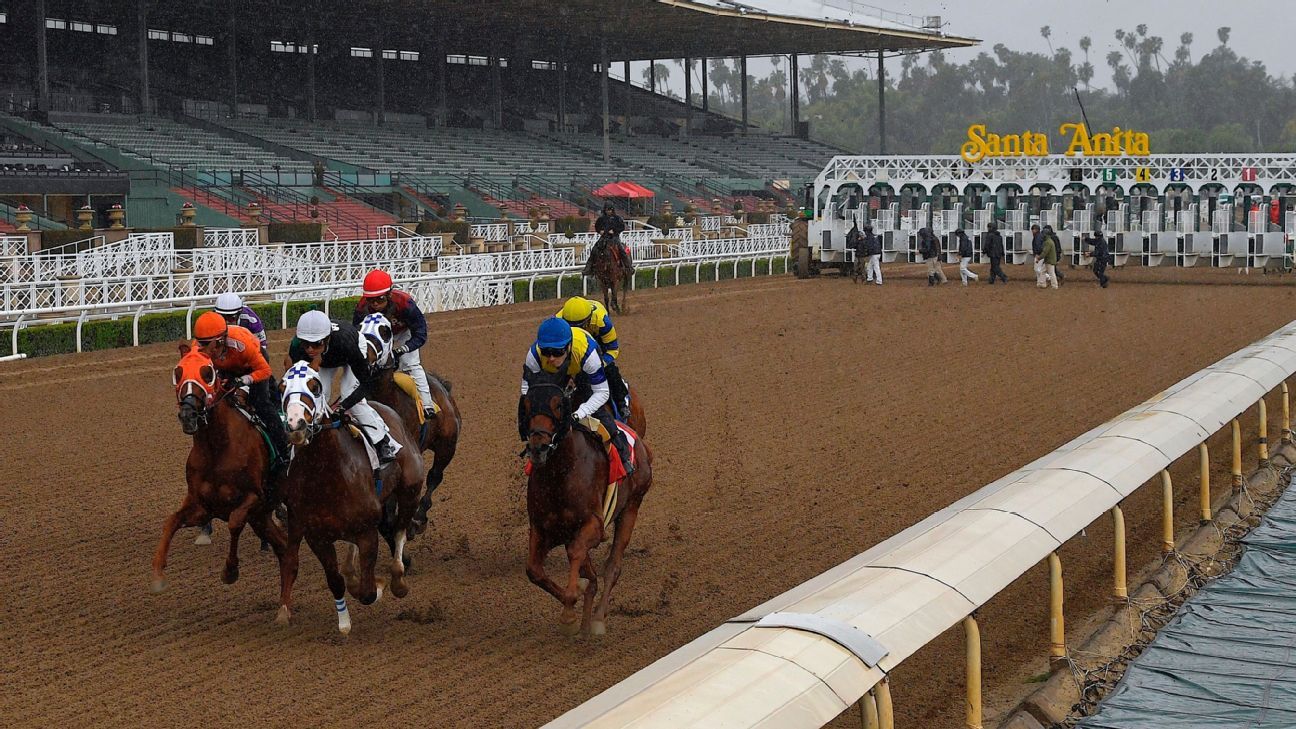LOS ANGELES — An executive with the company that owns Santa Anita urged the California Horse Racing Board on Thursday to continue live racing despite a statewide stay-at-home order to prevent the spread of the coronavirus.
Santa Anita in Arcadia, outside Los Angeles, and Golden Gate Fields in the San Francisco Bay area are among a handful of U.S. tracks continuing to race without fans. Both are owned by The Stronach Group.
“We are very different from almost every other industry. Horses need exercise,” Aidan Butler, acting executive director of California racing operations for Stronach, told the board during its monthly meeting held via conference call. “The second we stop racing, the whole ecosystem becomes in jeopardy.”
The issue of continuing live racing during the pandemic wasn’t on the board’s agenda, but the question was raised by board member Wendy Mitchell. During a public comment period on the call, several animal activists condemned the board for allowing live racing to continue.
Nationwide, Stronach-owned Gulfstream and Tampa Bay Downs in Florida, Oaklawn in Arkansas and Remington in Oklahoma City are staging live racing while the NBA and NHL have put their seasons on hold. Major League Baseball was supposed to begin its season Thursday, but it has been postponed.
“You can’t look at all tracks the same,” Butler said. “In California, we are not subsidized. We can sustain as long as we can keep the sport going.”
Gov. Gavin Newsom’s stay-at-home order for California has resulted in businesses shutting down or dramatically scaling back to protect against the spread of the virus.
Coronavirus cases in California are increasing as more testing is done. A tally by Johns Hopkins University counted over 3,200 confirmed cases and at least 65 deaths. For most people, the new coronavirus causes mild or moderate symptoms, such as fever and cough that clear up in two to three weeks. For some, especially older adults and people with existing health problems, it can cause more severe illness, including pneumonia and death.
Dr. Rick Arthur, equine medical director for the board, said continuing to race “certainly isn’t a medical necessity” for horses.
“It is a health consideration that they train,” he said. “These are very fit, healthy, very good feeling athletes, and you just can’t keep them in a stall. You have to get them out and train them.”
Santa Anita’s stable area has about 1,700 horses and 750 workers on the grounds. The track has racing Friday, Saturday and Sunday each week.
Arthur, whose office is located in the stable area, said “rather extraordinary” efforts have been made to maintain sanitary conditions.
“I want to make sure we’re making the best decision for the state of California and taking what the governor said very, very seriously,” Mitchell said. “Other tracks around the country are shutting down.”
Keeneland in Kentucky canceled its upcoming spring meet, and Aqueduct in New York cut short its meet after a backstretch employee who lives and works at Belmont Park tested positive for the virus.
“The optics of us continuing racing while the rest of the world is at home, I understand looks terrible,” Butler told the board.
However, he said a track’s stable area is “by its nature kind of a quarantined area.” Santa Anita’s backstretch workers typically live in dorms on the property and have access to an on-site health clinic. Butler said food that was to be used when the track was open to the public was redirected to stable workers, and food delivery has been set up so they don’t have to leave the property.
“I’m not trying to be alarmist,” Butler said. “I can assure you if we don’t keep everybody together and safe, we’re going to end up with a bunch of homeless people and a bunch of animal issues.”
Anyone coming to Santa Anita from out of state is first required to self-quarantine for 14 days.
Cliff Goodrich, executive director of the California Thoroughbred Horsemen’s Foundation, said if racing stops, workers would have nowhere to go and “end up out in communities with the risking of infecting others.”
He said he wasn’t aware of any backstretch workers being tested yet or of any coronavirus infections.
Goodrich said it costs $20,000 a day to maintain the stable area.
“Right now the only funding source we have is advanced deposit wagering,” he said. “If that shuts down, we would have to shut our doors and not be able to treat backstretch workers.”
Several animal activists used their two minutes during the public comment portion to assail the board. Some said they watched last weekend’s racing at Santa Anita online and noticed social distancing wasn’t being practiced and people were not wearing masks or gloves.
“Since you haven’t tested one person at the racetrack, who knows how many people are infected?” a woman said. “Horse racing is not essential to keep open.”
Oscar De La Torre, an advocate for backstretch workers, urged the board to keep workers and their families at the forefront.
“These workers are very vulnerable,” he said. “The fact that people can still work has given them a lot of certainty in their lives. We just need to make sure we’re thinking about the workers and their families at this time and allowing them the opportunities to continue to work, of course with safety first.”
Another activist said she noticed workers touching one another’s equipment during last weekend’s races.
“This is very irresponsible,” she said. “Coronavirus does not know any boundaries.”
